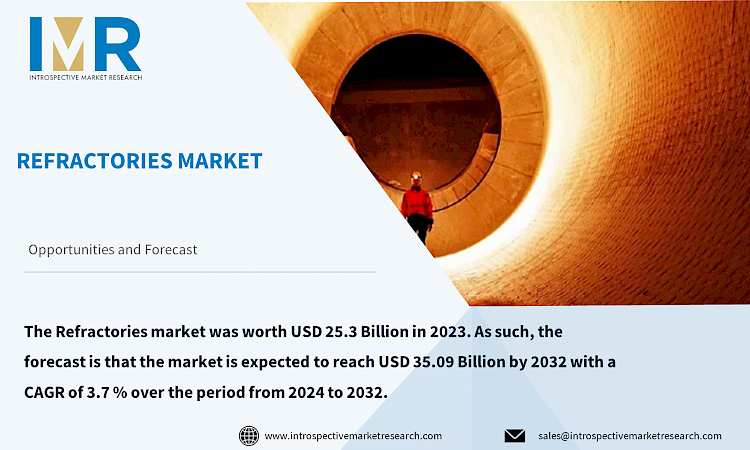
According to a new report published by Introspective Market Research, titled, “Refractories Market by Form, Alkalinity, and End-Use Industry: Opportunity Analysis and Industry Forecast, 2024–2030,” The Refractories market was worth USD 25.3 Billion in 2023. As such, the forecast is that the market is expected to reach USD 35.09 Billion by 2032 with a CAGR of 3.7 % over the period from 2024 to 2032.
Refractories are ceramic materials designed to withstand the very high temperatures (over 1,000°F [538°C]) encountered in modern manufacturing. More heat-resistant than metals, they are used to line the hot surfaces found inside many industrial processes.
Refractory products generally fall into one of two broad categories: preformed shapes or unformed compositions, often called specialty or monolithic refractories. Then, there are refractory ceramic fibers, which resemble residential insulation, but insulate at much higher temperatures. Bricks and shapes are the more traditional form of refractories and historically have accounted for the majority of refractory production.
Refractories come in all shapes and sizes. They can be pressed or molded for use in floors and walls, produced in interlocking shapes and wedges, or curved to fit the insides of boilers and ladles. Some refractory parts are small and possess a complex and delicate geometry; others, in the form of precast or fusion-cast blocks, are massive and may weigh several tons.
The construction of new infrastructure, including residential buildings, commercial complexes, and transportation networks, necessitates the use of refractories in various applications such as furnaces, kilns, and boilers. The growth of the construction sector, particularly in developing regions, is fueling the demand for refractories in industries like cement and glass manufacturing.
The expanding petrochemical industry, driven by rising energy consumption and industrialization, is contributing to the increased demand for refractories. Refractory linings are crucial for maintaining the integrity of high-temperature reactors and furnaces used in petrochemical processes, thereby driving market growth. The growing focus on sustainability and energy efficiency is driving innovation in refractory materials, with manufacturers developing eco-friendly and high-performance products to meet the evolving needs of end-users.
Refractories Market, Segmentation
The Refractories market is segmented based on Form, Alkalinity, and End-Use Industry.
Form:
The dominance of shaped refractories is their widespread usage across diverse industries such as iron & steel, cement, glass, and non-ferrous metals. In the iron & steel industry, shaped refractories are indispensable for lining furnaces, ladles, and other high-temperature equipment essential for metal production. Similarly, in the cement and glass industries, shaped refractories are crucial for lining kilns and furnaces, enabling efficient and continuous production processes. Moreover, advancements in manufacturing technologies have led to the development of high-performance shaped refractories with enhanced thermal stability, mechanical strength, and chemical resistance, further bolstering their demand across industries.
End-Use Industry:
The iron and steel industry stands as the cornerstone of the global refractories market, wielding significant influence due to its indispensable need for refractory materials. Refractories, vital for withstanding high temperatures in various industrial processes, find extensive application in iron and steel production. Blast furnaces, converters, ladles, and other equipment crucial to iron and steel manufacturing rely heavily on refractories to withstand extreme heat and chemical corrosion. This dominance is driven by the perpetual demand for steel, a fundamental material in the construction, automotive, and infrastructure industries worldwide. As emerging economies continue to urbanize and industrialize, the demand for steel remains robust, further fueling the need for refractories.
Region:
With rapid industrialization and urbanization, countries in this region such as China, India, Japan, and South Korea are witnessing significant growth in industries like steel, cement, glass, and non-ferrous metals, all of which are major consumers of refractories. Additionally, ongoing infrastructure development projects further fuel the demand for refractory materials. Moreover, the Asia Pacific region benefits from abundant reserves of raw materials required for refractory production, ensuring a steady supply chain. Furthermore, favorable government initiatives, increasing investments in research and development, and technological advancements in manufacturing processes contribute to the region's dominance in the market.
Some of The Leading/Active Market Players Are-
- RHI Magnesita (Austria)
- Vesuvius (United Kingdom)
- Krosaki Harima Corporation (Japan)
- Saint-Gobain (France)
- Shinagawa Refractories Co., Ltd. (Japan)
- Calderys (France)
- Morgan Advanced Materials (United Kingdom)
- HarbisonWalker International (United States)
- Refratechnik Holding GmbH (Germany)
- Puyang Refractories Group Co., Ltd. (China), Other Active players
Key Industry Developments:
- In June 2023, INTOCAST AG announced to acquisition of EXUS Refractories S.p.A, an Italy-based company named to upgrade a modern technological advancement in its production facility. This acquisition will help the company to strengthen its portfolio of refractory products.
- In April 2023, RHI Magnesita announced to acquisition of the U.S., India, and Europe operations of seven refractories, specialist suppliers of non-basic monolithic refractories with recorded revenue of USD 110 million and PBT of USD 12 million in 2022 with a market portfolio for various end-use applications across the global market. This acquisition will aim to bring innovative product categories and technological advancement to deliver a step change in consumer offerings.
Key Findings of the Study
- Shaped refractories hold significant sway across multiple industries including iron & steel, cement, glass, and non-ferrous metals due to their versatile applications in lining furnaces, kilns, ladles, and other high-temperature equipment.
- The iron and steel industry emerge as the cornerstone of the global refractories market, primarily due to its indispensable reliance on refractory materials for withstanding extreme temperatures and chemical corrosion in various industrial processes. The perpetual demand for steel, propelled by construction, automotive, and infrastructure sectors globally, further amplifies the need for refractories, especially in emerging economies undergoing rapid urbanization and industrialization.




